By sumit janu
Child Developmental Milestones Tracking Checklist
Track your child's developmental progress and know How to Monitor Your Child's Developmental Milestones?
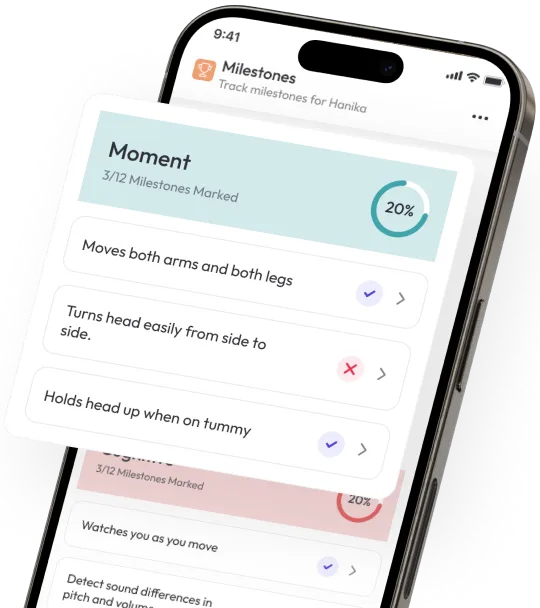
The ParentZ Child Developmental Milestone tracker and checklist allows parents to monitor and track their child's developmental progress against the list of important milestones using an interactive, illustrated checklist. You can also use the app to track child vaccination schedules, growth, medications, sleep, growth and teething. How to Monitor Your Child's Developmental Milestones? Download the Milestone Tracker mobile app to monitor and track your baby's developmental progress.
Digital Online Child Development Milestone Checklist
Bring hands near face
Movement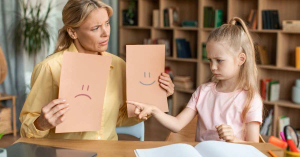
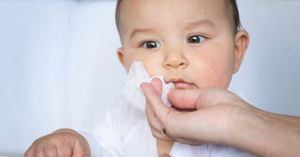
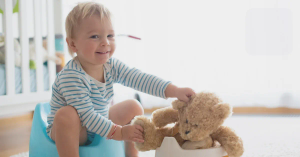

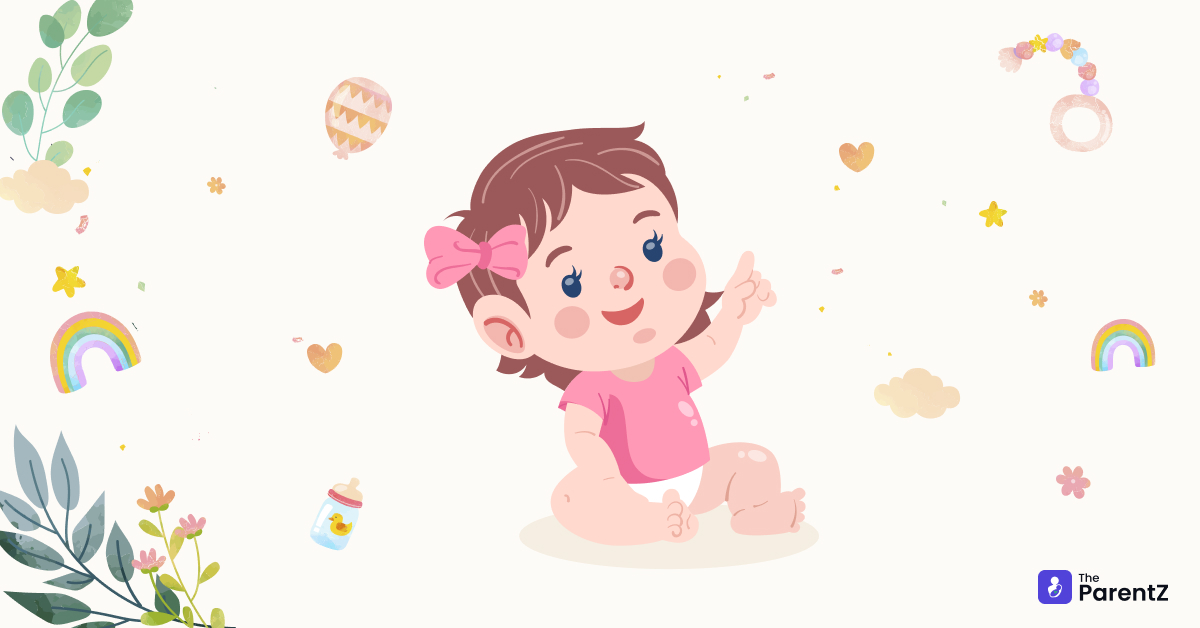
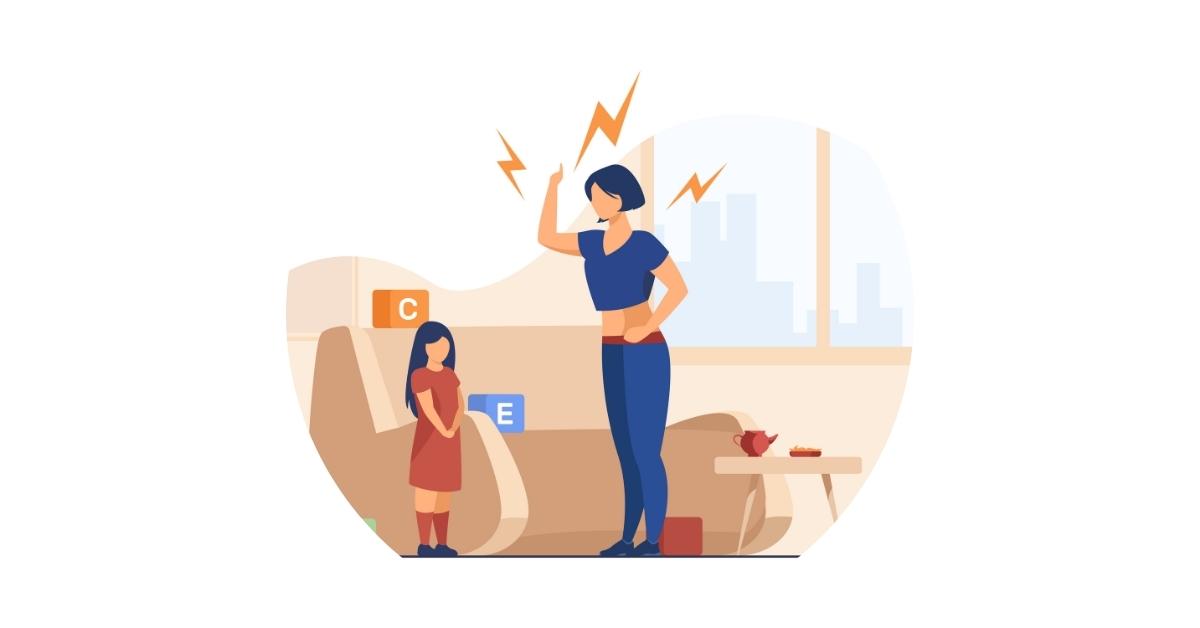
Begins to smile
Smiles when you talk to or smile at her
Social




Reacts to loud sounds
Communication




Seems happy to see you
Social




Makes sounds other than crying
Communication




Moves both arms and both legs
Movement




Looks at us and maintain eye contact
Social




Can recognize your smell
Cognitive




Starts focussing on moving objects (including face of caregiver) with eyes
Cognitive




Calms down when spoken to or picked up
Social




Turns head easily from side to side.
Movement




Can see things 8 to 12 inches away (eyesight is developing)
Cognitive




Looks at a toy for several seconds
Cognitive




Cries to communicate
Communication




Holds head up when on tummy
Movement




Watches you as you move
Cognitive




Detect sound differences in pitch and volume
Cognitive




Opens hands briefly
Movement




Shows excitement by waving arms and legs
Social




Recognize familiar faces
Cognitive




Chuckles when you try to make her laugh
Chuckles (not yet a full laugh) when you try to make her laugh
Social




Uses arm to swing at toys
Movement




Holds head steady without support
Movement




Holds a toy when you put it in their hand
Movement




Pushes up onto elbows/forearms when on tummy
Movement




Likes to play with people and might cry when playing stops
Social




Makes eye contact
Communication




Opens and closes hands
Movement




Comforts self by sucking on fist or fingers
Movement




Looks at you, moves, or makes sounds to get or keep your attention
Social




Brings hands to mouth
Movement




Follows moving objects with their eyes
Cognitive




Makes cooing sounds
Makes sounds like “oooo”, “aahh” (cooing)
Communication




Looks at his hands with interest
Cognitive




Smiles on his own to get your attention
Social




Turns head towards the sound of your voice
Communication




Makes sounds back when you talk to them
Communication




Recognises breast or bottle
Cognitive




Cries differently for different needs (e.g. hungry vs. tired)
Communication




If hungry, opens mouth when she sees breast or bottle
Cognitive




Turns head toward sounds
Movement




Begins to say consonant sounds like “b” and “m.”
Communication




Babbles and imitates sounds.
Communication




Reaches to grab a toy they want
Cognitive




Enjoys playing with others
Social




Takes turns making sounds with you
Communication




Grabs and shakes toys, brings hands to mouth.
Movement




Knows familiar people
Social




Imitates sounds and facial expressions
Social




Sticks tongue out and blows
Communication




Puts things in her mouth to explore them
Cognitive




Rocks from side to side and may roll over from tummy to back.
Movement




Likes to look at self in a mirror
Social




Begins to pass things from one hand to the other
Cognitive




Pushes up with straight arms when on tummy
Movement




While lying on back, reaches both hands to play with feet
Movement




Laughs
Social




Supports weight on both legs when standing
Movement




Makes squealing noises
Communication




Listens and responds when spoken to
Communication




Leans on hands to support self when sitting
Uses hands to support self while sitting
Movement




Closes lips to show they don’t want more food
Cognitive




Stands, Holding on
Movement




Knows familiar faces and begins to know if someone is a stranger.
Cognitive




Makes a lot of different sounds like “mamamama” and “bababababa”
Communication




Reacts when you leave (looks, reaches for you, or cries)
Social




Uses fingers to “rake” food towards himself
Movement




Could start to crawl
Movement




Sits without support
Movement




Clings to familiar adults
Social




Looks for things when you hide or dropped out of sight
Looks for objects when dropped out of sight (like his spoon or toy)
Cognitive




Moves things smoothly from one hand to other hand
Movement




Copies gestures such as nodding head for “yes” and shaking head for “no.
Communication




Lifts arms up to be picked up
Communication




Shows several facial expressions, like happy, sad, angry, and surprised
Social




Is shy, clingy, or fearful around strangers
Social




Rolls both ways (from tummy to back and back to tummy)
Movement




Bangs two things together
Explores things by banging, shaking or throwing.
Cognitive




Looks when you call his/her name
Social




Picks up small objects with thumbs and fingers
Movement




Might become attached to a special toy
Social




Shows feelings by smiling, crying and pointing
Social




Smiles or laughs when you play peek-a-boo
Social




Gets to a sitting position by herself
Movement




Plays games with you
Social




Understands “no”
Understands “no” (pauses briefly or stops when you say it)
Communication




Puts something in a container, like a block in a cup
Cognitive




Calls a parent “mama” or “dada” or another special name
Communication




Picks up things between thumb and index finger, like small bits of food
Picks things up between thumb and pointer finger, like small bits of food
Movement




Uses finger to point at things
Communication




Responds to simple requests with simple gestures such as shaking head
Communication




Imitates sounds, gestures or actions to get parent's attention.
Social




Uses simple gestures like shaking head “no” or waving “bye-bye”
Communication




Pulls to stand and stands, holding on.
Movement




Tries to say words
Communication




Manipulate objects by turning them over, trying to put one object into another, banging them etc.
Movement




Is shy or nervous with strangers
Social




Might walk holding on to furniture
Movement




Drinks from a cup without a lid, as you hold it
Movement




Explores things by banging, shaking or throwing
Cognitive




Gets in and out of sitting position
Movement




Looks for things baby sees you hide, like a toy under a blanket
Cognitive




Claps when excited
Social




Looks at a familiar object when you name it
Communication




Stacks at least two small objects
Stacks at least two small objects, like blocks
Cognitive




Tries to say one or two words besides “mama” or “dada,” like “ba” for ball or “da” for dog
Communication




Hugs stuffed animal or doll or other toy
Social




Shows you an object they like
Social




Follows directions given with both a gesture and words.
Follows directions given with both a gesture and words. For example, he gives you a toy when you hold out your hand and say, “Give me the toy.”
Communication




Uses fingers to feed herself some food
Movement




Tries to use things the right way
Tries to use things the right way, like a phone, cup, or book
Cognitive




Takes a few steps on his own
Movement




Shows you affection (hugs, cuddles, or kisses you)
Social




Copies other children while playing
Copies other children while playing, like taking toys out of a container when another child does
Social




Points to ask for something or to get help
Communication




Climbs on and off furniture without help
Climbs on and off a couch or chair without help
Movement




Can follow one step verbal command without any gestures, like giving you the toy when you say, “Give it to me.”
Follows one-step directions without any gestures, like giving you the toy when you say, “Give it to me.”
Communication




Moves away from you, but looks to make sure you are close by
Social




Points to show you something interesting
Social




Copies you doing chores, like sweeping with a broom
Cognitive




Tries to use a spoon
Movement




May remain standing without support
Movement




Tries to say three or more words besides “mama” or "dada"
Communication




Scribbles - May hold a marker and try to scribble
Movement




Helps you dress him by pushing arm through sleeve or lifting up foot
Social




Plays with toys in a simple way, like pushing a toy car
Plays with toys in a simple way, like pushing a toy car
Cognitive




Looks at a few pages in a book with you
Social




Drinks from a cup without a lid and may spill sometimes
Movement




Start walking without support
Walks without holding on to anyone or anything
Movement




Puts hands out for you to wash them
Social




Feed themselves with their fingers
Movement




Begins to use 2 word phrases
Says at least two words together, like “More milk.”
Communication




Tries to use switches, knobs, or buttons on a toy
Cognitive




Kicks a ball forward.
Movement




Holds something in one hand while using the other hand; for example, holding a container and taking the lid off
Cognitive




Uses more gestures than just waving and pointing, like blowing a kiss or nodding yes
Communication




Looks at your face to see how to react in a new situation
Social




Points to things in a book
Points to things in a book when you ask, like “Where is the bear?”
Communication




Notices when others are hurt or upset, like pausing or looking sad when someone is crying
Social




Walks (not climbs) up a few stairs with or without help
Movement




Plays with more than one toy at the same time
Plays with more than one toy at the same time, like putting toy food on a toy plate
Cognitive




Begins to run.
Movement




Eats with a spoon
Movement




Points to at least two body parts when you ask him to show you
Communication




Uses things to pretend, like feeding a block to a doll as if it were food
Uses things to pretend, like feeding a block to a doll as if it were food
Cognitive




Follows simple routines when told
Follows simple routines when told, like helping to pick up toys when you say, “It’s clean-up time.”
Social




Turns book pages, one at a time, when you read to her
Movement




Says about 50 words
Communication




Makes or copies straight line and circles
Cognitive




Plays next to other children and sometimes plays with them
Social




Says words like “I,” “me,” or “we”
Communication




Takes some clothes off by himself, like loose pants or an open jacket
Movement




Names things in a book when you point and ask
Names things in a book when you point and ask, “What is this?”
Communication




Shows you what she can do by saying, "Look at me!"
Social




Follows two-step instructions like "Put the toy down and close the door"
Cognitive




Starts to jumps with both feet leaving the ground
Movement




Knows at least one color
Shows he knows at least one color, like pointing to a red crayon when you ask, “Which one is red?”
Cognitive




Says two or more words, with one action word
Says two or more words, with one action word, like “Doggie run”
Communication




Shows simple problem-solving skills
Shows simple problem-solving skills, like standing on a small stool to reach something
Cognitive




Uses hands to twist things, like turning doorknobs or unscrewing lids
Movement




Talks clearly enough so that other can usually understand
Talks well enough for others to understand, most of the time
Communication




Calms down within 10 minutes after you leave her
Calms down within 10 minutes after you leave her, like at a childcare drop off
Social




Avoids touching hot objects, like a stove, when you warn her
Cognitive




Says first name, when asked
Communication




Asks “who,” “what,” “where,” or “why” questions, like “Where is mommy/daddy?”
Communication




Uses three-word sentences and carries on a conversation.
Talks with you in conversation using at least two back-and-forth exchanges
Communication




Strings items together, like large beads or macaroni
Movement




Uses a fork
Movement




Puts on some clothes by himself, like loose pants or a jacket
Movement




Notices other children and joins them to play
Social




Draws a circle, when you show him how
Cognitive




Says what action is happening in a picture or book when asked, like “running,” “eating,” or “playing”
Communication




Names a few colors of items
Cognitive




Asks to go play with children if none are around
Asks to go play with children if none are around, like “Can I play with Alex?”
Social




Asks “why,” “where,” “what,” “when” and “how” questions
Communication




Understands the concept of counting and may know numbers
Cognitive




Changes behavior based on where she is
Changes behavior based on where she is (place of worship, library, playground)
Social




Avoids danger, like not jumping from tall heights at the playground
Social




Says sentences with four or more words
Communication




Answers simple questions
Answers simple questions like “What is a coat for?” or “What is a crayon for?”
Communication




Pretends to be something else during play
Pretends to be something else during play (teacher, superhero, dog)
Social




Likes to be a "helper"
Social




Catches a bounced ball most of the time
Movement




Enjoys helping with simple household tasks
Social




Says some words from a song, story, or nursery rhyme from memory
Communication




Tells what comes next in a well-known story
Cognitive




Talks about at least one thing that happened during his day
Talks about at least one thing that happened during his day, like “I played soccer.”
Communication




Holds crayon or pencil between fingers and thumb (not a fist)
Movement




Comforts others who are hurt or sad, like hugging a crying friend
Social




Serves himself food or pours water, with adult supervision
Movement




Unbuttons some buttons
Movement




Draws a person with three or more body parts
Cognitive




Says first and last name
Communication




Maintain a longer attention span of around 5 to 10 minutes during activities
Pays attention for 5 to 10 minutes during activities. For example, during story time or making arts and crafts (screen not count)
Cognitive




Does simple chores at home, like matching socks or clearing the table after eating
Social




Keeps a conversation going with more than three back-and-forth exchanges
Communication




Answers simple questions about a book or story after you read or tell it to him
Communication




Writes some letters in her name
Cognitive




Buttons some buttons
Movement




Likes to sing, dance and act for you
Social




Names some numbers between 1 and 5 when you point to them
Cognitive




Says name and address
Communication




Follows rules or takes turns when playing games with other children
Social




Names some letters when you point to them
Cognitive




Hops on one foot, may be able to skip
Movement




Counts 10 or more objects
Cognitive




Begins to understand time
Uses words about time, like “yesterday,” “tomorrow,” “morning,” or “night”
Cognitive




Uses or recognizes simple rhymes
Uses or recognizes simple rhymes (bat-cat, ball-tall)
Communication




Tells a story they heard or made up with at least two events in complete sentences
Tells a story she heard or made up with at least two events. For example, a cat was stuck in a tree and a firefighter saved it
Communication




Child Developmental Milestone Checklists For All Ages
Monitoring development milestones using these CDC’s developmental checklists helps you determine how your child is growing and changing over time. It also helps in determining if they are meeting the typical social/emotional, cognitive (learning), language (speaking & communicating) and physical developmental milestones. Click on the month in the above section to see the milestones corresponding to that month.
Please note these are easy ways for parents to check your child’s development incase your child is not meeting any milestone don’t wait, act early and visit your child’s doctor (pediatrician).
Developmental Screening
The Pediatrics across the world recommends developmental and behavioral screening for all children during the visit to pediatrician especially when they have reached the below ages
- 9 months
- 18 months
- 30 months
In addition, Pediatrics also recommends autism spectrum disorder (ASD) screening of all children at age 18 months and 24 months.
The ParentZ Milestone Tracker App
Track your child’s milestones from birth to 5 years with our easy-to-use illustrated checklist. We provide easy to understand dashboard for parents to get an overview of the milestones achieved under each category of milestones – Social, Cognitive, Language and physical.
Track each milestones along with the photos and videos for future reference. Download Milestone Tracker App Now from App Store or Google Play.
We don’t share any personal information that can be used to identify you or your child with anyone expect you or caregiver or doctor or family member to whom you have given access using the app.
We track the child’s milestones against the milestones recommended by the CDC.
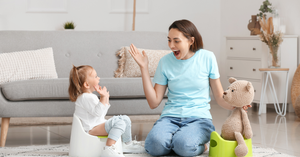
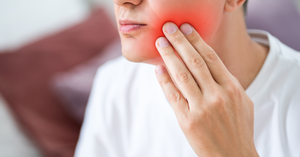
![[object Object]](/assets/img/theparentz_logo.png)





![[object Object]](/assets/img/download-app-vertical.png)